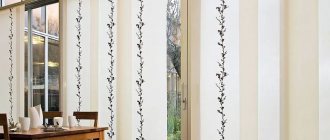Types of installation
There are four types of blind installation:
- To the opening
- In the doorway
- To the ceiling
- On the sash
Not every type of blind allows you to choose from all four options. This is due to the technical features and functionality of different designs. But you shouldn’t assume that the best blinds are those that can be installed in any of the four available ways. Perhaps your best option involves only one type of installation, but it will be the ideal choice for your room.
Installation of blinds on the opening
Installation on the opening is suitable for situations where the window is not too recessed into the wall. Otherwise, the blinds will look more like a screen, which will ruin the appearance of the window. For deep-set windows, it is better to choose classic curtains or blinds installed in the opening.
This type of installation is also good for maximum darkening of the room. Due to the fact that part of the canvas will block the opening on both sides, sunlight will not be able to penetrate the cracks around the perimeter of the window.
For installation in situations where the window is in the same plane with the wall or is slightly recessed, special brackets are used
The dimensions of the blinds for installation on the opening should be:
- Width: 5 cm on each side more than the width of the opening, more is possible. The farther the canvas is located from the wall, the greater the width that needs to be covered in order to achieve good darkening;
- Height: 10 cm more than the height of the opening if the window sill does not interfere with the position of the canvas. Height may vary. So for vertical blinds, the height can be equal to the distance from the eaves to the floor.
While it’s easy to determine the length of the canvas, you may not be able to guess the dimensions of the box. Place the box against the wall in advance and check whether its location will interfere with the opening of the window sashes
Tools for door mounting
For installation on the opening you will need:
- Hammer
- Level
- Pencil or marker
- Plastic dowels and screws
- Screwdriver (screwdriver)
Before starting work, be sure to attach the structure to the wall to make sure that the calculations are made correctly and the width of the canvas complies with the standards. Using a level, make marks in the places where the brackets will be attached, drill holes there and insert plastic dowels and screw screws into them, after inserting them into the mounts.
Marking places for drilling for brackets
The wider the canvas, the heavier it is, and the stronger the fastening under it should be. For blinds more than 1.5 meters wide, use not two, but three fasteners. If you can choose the construction material, choose aluminum. It is quite durable, lightweight and retains its shape for many years.
After installing the brackets, all that remains is to insert the box with blinds into the latches on them and check the reliability of its fixation. If everything is in order, proceed to setting up the controls.
We take measurements
You need to decide on the type of blinds (horizontal, vertical) and the method of installing them (on a wall, on a ceiling, in a sash window, in a window opening) before purchasing. And even before you start measuring. Because different installation methods require different sizes. Only with correct measurements will it be easy to install blinds on plastic windows.
For everything to work well, you need to take the measurements correctly.
Another important point: you need to measure each window separately . Sometimes it just seems like they are absolutely the same. Believe me, there is a difference. You also need to write down the measurement results and sign which specific window you measured and which sash it is. Accurate and detailed records will help avoid confusion during purchase and installation.
In the window opening
Although the appearance of the products is different, when measuring there is no difference between horizontal and vertical models. If you are going to install blinds in a window opening, you need to subtract 2 cm from its width on each side. You can subtract 1-3 cm from the height of the opening. Such gaps are needed so that the canvas hangs freely in the opening and the lower edge of the slats does not rub against the window sill.
How to measure when installing in a window opening
Please note that you can install blinds on plastic windows “in the opening” not flush with the edge of the opening, but deeper - near the glass itself or by stepping back 5 or more centimeters from the edge. If the opening has a trapezoidal shape, the height/width of the opening will be smaller for the glass, so we take careful measurements. And also, in this case, it is better to put marks for installation when measuring. Then you will know exactly where you will need to install blinds on plastic windows so that their dimensions fit perfectly.
On the ceiling or wall
Here the measurements depend on your desires. The length of the blinds can be up to the floor or just up to the window sill. Moreover, depending on the type of installation chosen, the slats can cover the window sill or not. So the length is whatever you like.
This is wall mounting. When mounted on the ceiling, the length will increase, but how much is up to you
The width of the blinds with this installation method is wider than the window opening. How much wider depends on your desire, but the minimum offset is 5 cm on each side. But if the window is in the same plane as the wall surface, you will need additional brackets, which are not included in the package: the slats must be placed at a distance of at least 5 cm from the glass surface so that they do not interfere with opening the doors for ventilation.
On the doors
When installing blinds on a multi-leaf window, there are two options - install one device on each sash or order one long one for the entire window. Usually the first option is chosen - it makes it possible to open and close the shutters with the blinds lowered. If you choose this installation method, you will need to measure each sash and record the results. The doors may be different, so be careful.
The option on the right is more convenient
The width of the blinds when installed on the shutters is taken to be 3 cm wider than the glass. When hanging, the lamellas overlap the profile by 1.5 cm. This is convenient and does not interfere with opening/closing windows. The length depends on the location of the fastener, but usually it is 5 cm longer than the height of the glass.
Once again we draw your attention: we measure each sash!
Installing blinds in the opening
Blinds are installed in the opening if the window is deeply recessed into the wall. If you plan to place plants or some things on the windowsill that do not need to be hidden from prying eyes, this option will come in handy. Plants also benefit greatly from this type of installation. They can be protected from the sun when necessary by simply lowering the curtain.
This type of installation has three subtypes:
- On the upper (fixed) part of the frame
- On the wall above the window
- To the top of the niche
There are no differences in the dimensions of the canvas depending on the subtype. For all blinds that will be installed in the opening, there are rules for choosing the size:
- Width: 4 cm less than the width of the opening at the narrowest point (usually at the frame). This will make it possible to easily adjust the blinds, and will also provide a margin of width for the box - it usually has a larger width than the canvas;
- Height: 2 cm less than the height of the opening. In this case, the box must be positioned so that its lower border is located above the opening of the sash, otherwise it will not be possible to open the window.
Fastening into the opening is convenient, but may not be available if the distance from the sash to the top of the window opening is less than the thickness of the frame. In this case, you will have to choose a different installation option.
Tools you'll need
- Screwdriver. This is the only tool needed to mount it to the frame. If you need to drill a wall, then you also need to stock up on a hammer drill.
- Building level
- Pencil or marker
- Plastic dowels and screws
- Mounting brackets - wall brackets are usually included. If installation is planned to be carried out in the upper part of the opening, special ceiling brackets will be needed.
Try the design on the opening, make sure that the window sashes open without touching the frame, and that the canvas moves freely without touching the walls.
Using a level and a pencil, mark the points where you will need to drill holes. If you are drilling into a wall, use a hammer drill, then insert dowels into the holes and screw in the screws, threading them through the blind mounts. If you are drilling a window frame, immediately use plastic screws.
After this, all that remains is to secure the box with blinds in the installed brackets and check the reliability of the structure. The entire system must be motionless. After this, we move on to debugging the canvas control.
Installing the canvas on brackets using the example of horizontal blinds (installation in an opening)
Attaching blinds to the sash
This installation option is perfect for situations where installation on the opening is undesirable due to the large depth of the window, and it will not be possible to install it in the opening, since the frame will interfere with the movement of the sash.
Separate leaves are installed on each sash - both opening and fixed. This method combines all the advantages of mounting in an opening and adds to them the convenience of opening the window.
To prevent the blinds from hanging at an angle to the sash when opening for top ventilation, use cassette structures or magnets to hold the bottom strip of the curtain
It is for mounting on the sash that installation methods without drilling are often used to avoid unsightly holes if the blinds are removed.
Dimensions requirements:
- Width: 3 cm larger than the width of the glass. In this case, the rule “the wider, the better” does not apply, which is true for the option of mounting on an opening. You should not go too far beyond the boundaries of the glass. The solar flow will already be well blocked due to the proximity of the canvas to the glass. And excessive width can rest against the handle, which will harm both control and aesthetics;
- Height: 3-5 cm more than the height of the glass. When choosing blinds with magnetic fastening of the bottom strip of the canvas, keep in mind that the length should be such that the bottom of the canvas reaches the magnet.
Sash mounting tools
For installation you will need:
- Screwdriver – for drilling installation method
- Pencil or marker
- Self-tapping screws
- Plastic clips or tape clips - for the no-drilling method
Mark with a pencil the points where you need to drill to install the brackets. If using the no-drill method, simply install the fasteners by hooking them onto the top edge of the frame or taping them in place. Before doing this, thoroughly wipe the frame and degrease it. The latches should be located a few centimeters from the edges of the frame.
After installing the fastener, you can begin installing the canvas itself. It snaps into the mounts, after which the reliability of the system is checked. The last stage of work is the installation of the lower magnets. They are installed where the lower strip of the canvas reaches when stretched. To be sure, make the markings, then install the magnets. Now you can move on to debugging the design.
Installing blinds into sash mounts
Installation of blinds on the ceiling
Sometimes ceiling mounting is the best option. You need to consider the type of ceiling in order to choose the right tools.
Installation on a concrete ceiling is the easiest. Here you will need:
- Latches (usually included)
- Ladder
- Roulette
- Drill
- Screwdriver
- Pencil
- Plastic dowels and screws
The location is determined so that the canvas does not touch the window sill, but is not too far from the window. The ideal distance from the wall to the brackets is 10-15 cm. To check the selected location, lower a plumb line from it.
The longer the blinds, the wider the canvas can be. If the blinds reach the length of the window sill, they can protrude beyond the border of the opening on the sides by 5 cm on each side
Once a suitable location has been selected, places on the ceiling for drilling holes for fasteners are marked with a pencil. The blinds will be installed directly on the ceiling. The number of fastenings depends on the weight of the canvas (width plus length). Standard blinds up to the window sill on a standard opening will require 2-3 fastenings. Long and heavy structures are recommended to be installed in fastenings located at a distance of 1 m from each other.
After drilling the slab, dowels are inserted into it and screws are screwed in, then the latches and cornice are installed. The canvas will be attached to the cornice.
Vertical blinds mounted on the ceiling
Installation to a suspended ceiling differs from the previous version in that it requires preliminary installation of a mortgage. This is a beam that is hidden under a suspended ceiling in order to later attach blinds to it. The decorative ceiling material itself will not withstand such a load.
The fastenings for the cornice are screwed to the mortgage with self-tapping screws, the length of which is specially chosen so that they reach the depth of the beam, passing through the material of the suspended ceiling. Further actions are not too different from installation in a concrete ceiling. However, here the task is simplified. For fastening to timber, dowels are not needed; ordinary self-tapping screws will suffice.
Sometimes it happens that the idea to buy blinds did not come immediately, and the ceiling is already done, but the mortgage has not been prepared. In this case, you can use long screws that are screwed through the decorative ceiling material into the concrete floor.
Attaching blinds to the Armstrong ceiling is even easier. This suspended ceiling design provides for fastening the brackets to the guides.
Special fasteners for the Armstrong ceiling
Blinds are also installed on suspended ceilings. But here it’s definitely worth considering the options before installing the ceiling. As in the case of a suspended ceiling, it is best to fix a beam on a concrete base, which will be of sufficient thickness corresponding to the distance from the ceiling to the ceiling. A smaller beam size will force the decorative ceiling to retract when installing blinds, and a larger one will stick out.
The installation itself into the timber occurs in the same way as in the previous version. Only the preparation for work will need to be more complex. To prevent the ceiling from spreading, the places of future holes are reinforced with reinforced tape or projector rings.
When planning a stretch ceiling, you can also provide space for blinds and step back from the wall with the window a short distance to the size of the blinds. This will create a sort of recessed, hidden mount in the niche. Then the baguettes on which the ceiling will be stretched rest on a beam installed in a niche.
If you started thinking about blinds after decorating the ceilings, you can use special corner mounts that are installed on the wall, and the cornice is attached to them through the upper holes in the corners.
Ceiling mounting is used not only for installing light filters on windows, but also for zoning a room. With the help of blinds fixed in the center of the room to the ceiling, you can divide it into two parts. For this purpose, vertical blinds are chosen, and rope slats are especially popular in zoning.
Blinds installed on the ceiling to zone the room
How to install blinds on plastic windows: attach to a wall or window opening
The first step is to apply markings. We install brackets in the cornice. We place them on the right and left so that they do not interfere with the operation of the blinds. The installation height depends on the selected product length.
We attach the curtains, mark with a pencil on the wall the places for installing fasteners in the brackets. If we are installing horizontal blinds (they are light and create almost no load), it is enough to install one screw/dowel. Vertical ones are heavier, so you need to install all the fasteners from the kit.
Installing blinds on the ceiling and walls is the same. Only the mounting location of the bracket changes
There is a second way. At the selected level, use a building level to draw a horizontal line, try to avoid tilting - this will affect the blinds (skew). Place the bottom of the bracket against this line and use a pencil to mark the holes for drilling. If the length of the cornice is more than 2 m, an additional bracket is required to increase the rigidity of the structure, which is attached in the middle.
This is what vertical blinds look like installed in a window opening
When attaching to brick or concrete, drill holes in the wall or ceiling at the marked points. A drill or a hammer drill - whoever has what is available. The diameter of the drill depends on the size of the dowels. They usually come included, but you can supply your own.
We insert spacer dowels into the finished holes and carefully hammer them in with a hammer. We install the brackets, fasten them with screws or nails (if dowel-nails are used). We install the cornice on the brackets and insert the plugs on the sides. For horizontal blinds, attach a rod (handle) to control the swing mechanism. To do this, install a special hook (included) directly into the mechanism itself, and attach the tip of the rod to this hook.
Methods of fixing the structure
You can fix the blinds using dowels and screws (if we are talking about installation on a wall) or self-tapping screws (if installing directly on a plastic frame).
There are three types of fastening methods:
- Drilling
- Fixed with double-sided tape
- Fixed with plastic brackets
The second and third methods refer to installation methods without drilling.
Installing blinds using drilling
When choosing the option with drilling, you must first check whether the window sashes open freely and whether the blinds do not interfere with them; can the canvas move freely, does it not touch the controls or objects on the window sill.
Installing blinds using double-sided tape (left) and a bracket (right)
Recently, it is believed that installation without drilling is better and more gentle. The fact that it does not deteriorate the appearance of the walls or frame is indisputable. But it’s difficult to call it the best.
Installing blinds without drilling: is it worth it?
Mounting methods using magnets, brackets and double-sided tape do not require drilling. On the one hand, this is an undeniable plus - this way the doors or walls remain undamaged. On the other hand, despite the assurances of manufacturers, installing blinds on plastic windows does not inspire confidence in the reliability of this procedure.
Blinds installed on curtain rods with self-tapping screws will hang for years. You can’t tear them off, you can’t peel them off, they will withstand all tests. The only problem is to correctly mark the places for installing the fasteners from the very beginning and not make a mistake. Correcting misalignment in the case of drilling is more difficult. If you cannot install the blinds yourself, contact a specialist.
Some people refuse the drilling option, fearing that it will damage the glass unit and reduce its protective properties. Manufacturers of PVC windows have formulated a clear answer to these concerns: fasteners for blinds are guaranteed not to cause damage to the double-glazed window. The length of the self-tapping screw for installing blinds is 1 cm. This is not enough to reach the reinforced parts and does not create a cold bridge. Manufacturers of plastic windows themselves call self-tapping installation the best choice.
Fastening with tape or brackets on the sash leaves the appearance of the window unchanged, although two small holes from self-tapping screws in the case of classic installation can hardly be called changes. However, they have their drawbacks. Brackets are prone to breakage and will last much less than classic designs. They also compress the seal on the sash and over time it ceases to hermetically seal the opening.
When the sash is tilted sharply, the plastic brackets can fly off, and for tilting windows they are almost never used
If exposed to high heat, the adhesive of double-sided tape may melt and lose its properties. In addition, the adhesive on the tape itself often does not wash off and spoils the appearance of the blinds much more than two screws.
Blinds fixed without drilling will not pass inspection by curious pets
Designs and installation methods
There are two types of blinds for windows - vertical and horizontal. Vertical slats are usually made of plastic or special dense fabric, cut into strips 10-15 cm wide. Less commonly, you can find slats made of aluminum or synthetic threads.
Vertical blinds can be used not only for windows, but also for plastic doors with full glazing
The slats of horizontal blinds come in plastic, wood and metal. Regardless of the type and material, they consist of a cornice and slats. Cornice is a plastic or aluminum U-shaped profile in which the controls are located and from which the lamellas are suspended. Lamels are horizontal or vertical stripes/plates that actually cover the opening. In order to be able to open and close the blinds, there are controls - chains or threads.
The design of horizontal blinds includes a large number of threads
In horizontal models there is also a control rod connected to a rotating mechanism. By rotating the rod, the angle of inclination of the lamellas is changed. This is how you can change the amount of light and the “degree of transparency” of the window. If the slats are placed vertically (almost), they completely block the view. When positioned horizontally, they hardly interfere with the view, but there are many other positions.
Installation of horizontal and vertical blinds
When installing blinds, you need to attach the cornice. To fix it, the kit includes specially designed brackets. These brackets are attached to the window or wall, and the cornice is simply put on them (until it clicks).
There are several ways to install blinds on sash windows:
- Directly on each window sash. This installation method will allow you to use the window sill at any time. The only limitation is that you cannot place objects close to the frame. Many people are afraid of the need to make holes in the PVC profile with this installation method. The presence of several additional holes in the plastic does not affect the properties of the window. In addition, blinds can be attached to an opening window sash without drilling .
- Secure it in the opening so that only the window is covered, but not the adjacent walls. With this installation method, the cornice is attached to the upper slope.
- Attach to the ceiling. In this case, there should be enough space to open the sash (at least 5 cm).
- On the wall. Attach the curtain rod directly to the wall above the window.
- Install on additional long brackets. This option is suitable for shallow window openings, when blinds hanging close to the wall do not allow the sash to be opened.
How to install blinds on plastic windows: installation methods
You will have to decide on the method of installing the blinds before purchasing: the size of the canvas depends on this. So the type of installation must be chosen before taking measurements.
Installation of horizontal blinds
Horizontal blinds can be installed in three ways:
- To the opening
- In the doorway
- On the window
A separate mounting method - in the glass unit sash - is available for inter-frame blinds. The choice of colors for such structures is quite limited, and they are used mainly in office-type premises and in medical institutions, designed in accordance with the requirements of SanPiN.
Horizontal blinds look great when installed flush with the wall
Measurements
Parameters for installation on the opening:
- The width of horizontal blinds is equal to the width of the opening plus 10 cm.
- Height - from the place where the cornice is attached (approximately plus 5 cm to the height of the window opening) to the beginning of the window sill or below it.
Parameters for installation in the opening:
- Width – the smaller value of the height (measurements are taken at three points) minus 4 cm.
- Height – from the bottom of the cornice to the window sill minus 2 cm.
- The length of the chain is 2/3 of the window height.
Parameters for installation on the sash:
- Width – the distance between the sash beads plus 2 cm.
- Height – the distance from the cornice to the bottom bead plus 2 cm. If a bottom magnet is installed, the length of the blinds is equal to the distance from the cornice to the bottom of the strip for magnetization.
Free-hanging canvases are good on blind windows. And with opening ones, you can do without magnets without losing convenience. To do this, choose cassette horizontal blinds. Their canvas moves, being pressed to the frame by guides, and does not deviate anywhere and does not ring even during vertical ventilation.
Installation of vertical blinds
Vertical blinds are the only type of light filter that looks great when mounted on a ceiling. But installation on the sash is not possible for them due to the large width of the lamellas.
Installation of vertical blinds on windows can be done in one of three ways:
- To the opening
- In the doorway
- To the ceiling
Vertical blinds, thanks to their design, look great in the maxi version - covering the entire wall and hanging down to the floor. The larger the fabric of such blinds, the more aesthetically pleasing the installation under the ceiling or on the ceiling looks.
Ceiling mounting is often used for roof windows
Depending on the length of the vertical blinds, the type of installation is selected
Measurements
For installation on the opening:
- The width is equal to the width of the opening plus 10 cm. The larger the canvas, the further it is from the window, the more allowance on the sides is needed
- Length – depends on preference. It is measured from the bottom of the cornice to the desired level.
For installation in the opening:
- The width is equal to the minimum opening width minus 2 cm.
- Length is the distance from the bottom of the cornice to the window sill minus 2 cm.
For installation on the ceiling, the length and width are calculated in the same way as in the case of installation on an opening. However, it is worth considering that installing long vertical blinds on the ceiling will visually increase the distance from floor to ceiling, and too narrow a canvas will look out of place. It is worth choosing either wide structures or shortened lamellas for ceiling mounting. Multi-textured blinds are perfect as a shortened option.
Which blinds are best to choose based on the characteristics of the material?
Various materials can be used to make planks. Most often just one, but a combination of two or even several is also possible. Such multi-textured products are very impressive. For the production of planks choose:
Plastic
An excellent choice for rooms with difficult operating conditions: high humidity, temperature changes, etc. Well suited for loggias, bathrooms and kitchens. Plastic products are lightweight, moisture-resistant and durable. They are very easy to care for. The design of the lamellas can be very different. Plastic is easy to paint and can be applied to various textures. Poor quality plastic may yellow, break or become deformed.
Metal
This is usually aluminum or its alloys. Lightweight, inexpensive, resistant to moisture and high temperatures, planks were once indispensable in offices and production. Nowadays it is better to choose such blinds for the kitchen or for a glazed balcony. You can choose original models with perforation or a special velvety coating. Aluminum plates can become deformed and rattle unpleasantly, but these are, perhaps, all their disadvantages.
Instagram dekorokon.kz
Aluminum blinds belong to the budget category. Despite this, they are durable, strong and quite attractive.
Tree
An elite option for living rooms and bedrooms in a classic style. Beautiful, respectable and durable. The lamellas are environmentally friendly, hold their shape well, and are easy to care for. The disadvantages of wood plates depend on the raw material. Inexpensive wood can break and fade. In any case, the tree is “threatened” by fluctuations in humidity. In short, without special treatment and regular maintenance, the slats can dry out or deteriorate from moisture.
- Decoration
6 modern options for using wood in the interior
Textile
Versatile, practical and beautiful. The big advantage of the material is that you can use different fabrics:
- Polyester. UV-resistant, dense, does not shrink. It is easy to care for.
- Fiberglass fabric. It is characterized by increased strength, does not deform or shrink, and does not burn.
- Cotton. It is environmentally friendly and has an attractive appearance. It is worth choosing only the densest varieties so that the lamellas do not become deformed. Linen, another natural material, is close to it in properties. Both may shrink when washed.
- Jacquard. Fabric made from synthetic or mixed threads with a special dense weave. According to reviews, they protect better than others from sunlight and provide maximum darkness.
Instagram dekorokon.kz
Fabric slats are impregnated with special solutions, which greatly simplify product care.
There is no need to be afraid of “rag” structures. All of them are necessarily treated with impregnations that repel dust, moisture, and dirt. Therefore, caring for them is extremely simple. This is dry cleaning for cotton or linen and wet cleaning for everything else. Polyester or fiberglass can easily even be washed in a machine.











